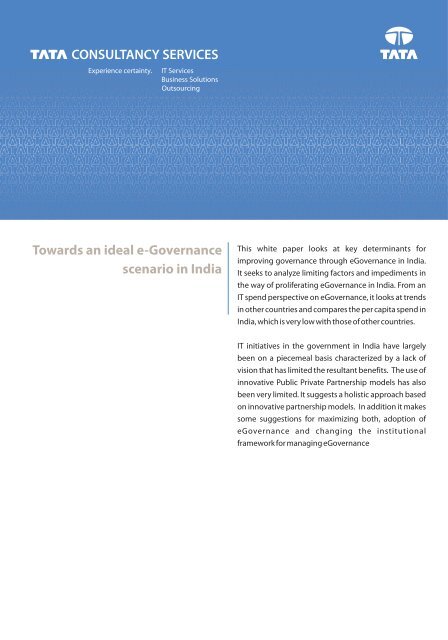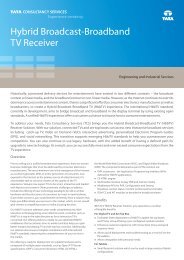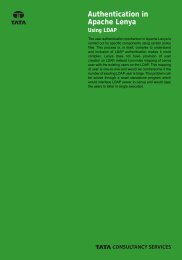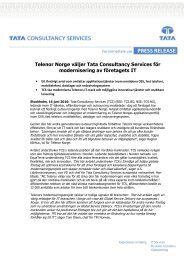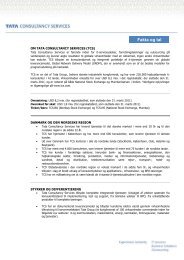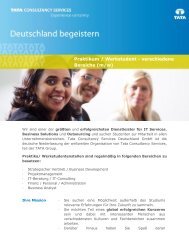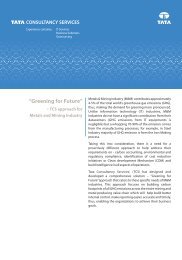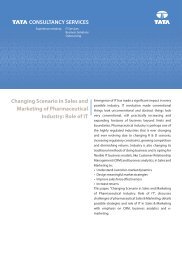TCS eGov - Tata Consultancy Services
TCS eGov - Tata Consultancy Services
TCS eGov - Tata Consultancy Services
Create successful ePaper yourself
Turn your PDF publications into a flip-book with our unique Google optimized e-Paper software.
Towards an ideal e-Governance<br />
scenario in India<br />
This white paper looks at key determinants for<br />
improving governance through <strong>eGov</strong>ernance in India.<br />
It seeks to analyze limiting factors and impediments in<br />
the way of proliferating <strong>eGov</strong>ernance in India. From an<br />
IT spend perspective on <strong>eGov</strong>ernance, it looks at trends<br />
in other countries and compares the per capita spend in<br />
India, which is very low with those of other countries.<br />
IT initiatives in the government in India have largely<br />
been on a piecemeal basis characterized by a lack of<br />
vision that has limited the resultant benefits. The use of<br />
innovative Public Private Partnership models has also<br />
been very limited. It suggests a holistic approach based<br />
on innovative partnership models. In addition it makes<br />
some suggestions for maximizing both, adoption of<br />
<strong>eGov</strong>ernance and changing the institutional<br />
framework for managing <strong>eGov</strong>ernance
1<br />
Towards an ideal e-Governance scenario in India<br />
About the Author<br />
Tanmoy Chakrabarty<br />
<strong>Tata</strong> <strong>Consultancy</strong> <strong>Services</strong><br />
Tanmoy is a Vice President who heads the Government<br />
Industry Solutions Unit in <strong>TCS</strong>. He is responsible for<br />
sales and delivery of solutions to the government<br />
customers globally. With over two decades of<br />
experience interrelated with the government, he is<br />
considered an expert on e-Governance<br />
Tanmoy holds a Bachelor's Degree in Commerce from<br />
St. Xavier's College, Calcutta and is an MBA from IMM,<br />
Calcutta. He has completed an Executive Development<br />
Program from The Babson College, Boston,<br />
Massachusetts, USA.
Table of Content<br />
1. Introduction 3<br />
2. Towards Implementing e-Governance In India 5<br />
3. Conclusion 10<br />
4. Some Successful E-Governance Projects in India 11<br />
2<br />
Towards an ideal e-Governance scenario in India
Introduction<br />
e-Governance has the potential to benefit India’s citizens exponentially and maximise the return on the<br />
government’s investment in it.<br />
The contradiction in India is that the country is rightly recognised a global leader in the delivery of IT services, but it<br />
suffers from very little internal IT development in the country. Where as technology leads, it tends to be in the private<br />
sector, by companies, corporations and non-governmental groups. Where it is the weakest – and where it can have<br />
the greatest impact - is in the public sector.<br />
� The Economist Intelligence Unit’s annual e-readiness ranks India at 54 out of the World’s 69 largest economies<br />
along with the Philippines. India has moved down by one rank since 2006.<br />
�The NASSCOM report on Information Technology on the Economy of India highlights that, despite India's global<br />
IT dominance, internally, the country has a low level of IT investment - only 3.5 per cent of total capital - and<br />
minimal dispersal of IT capital of 30 countries evaluated.<br />
�The World Economic Forum (WEF) Global Information Technology Report (2006-2007) ranks India at 44 (out of a<br />
total of 122 countries). Ahead of India are countries including Tunisia, Qatar, Thailand, Italy, Lithuania, Barbados,<br />
Slovak Republic, Latvia and Cyprus.<br />
�The WEF’s ‘Global Competitiveness Report (2007-2008)’ also ranks India at 45 out of a total of 122 countries. India<br />
has come down by 3 ranks from 42nd in 2006-2007 to 45 in 2007-08.<br />
�The World Bank’s Doing Business 2008 report data positions India at 120 (out of 178 economies) in the overall<br />
"Ease of Doing Business" ranking.<br />
The Global Scenario<br />
The World Economic Forum’s league table measuring the impact of technology on the development of nations,<br />
places Denmark at the top of the list for technological advancement, with other Nordic countries Sweden, Finland<br />
and Norway claiming second, fourth and 10th place respectively. The same report notes that:<br />
"Denmark, in particular, has benefited from the very effective government e-leadership, reflected in early<br />
liberalisation of the telecommunications sector, a first-rate regulatory environment and large availability of e-<br />
government services.”<br />
So, for a country to be considered to be technologically advanced, e-Governance is a key requirement and<br />
measurement.<br />
e-Governance is defined for the purposes of this paper as the application of electronic means in the interaction<br />
between government and citizens and government and businesses, as well as in internal government operations to<br />
simplify and improve democratic, government and business aspects of governance.<br />
3<br />
Towards an ideal e-Governance scenario in India
But e-Governance is not just about improving delivery of services to citizens, businesses and government<br />
employees. It is also about blending Information and Communications Technology (ICT) with administrative<br />
reforms to make government more efficient, drive down costs and increase transparency in how government<br />
departments work. If implemented properly, it can be an asset for the un-served and under-served areas in India and<br />
help drive new levels of efficiency to government services in India.<br />
Electronic invoicing in Denmark saves businesses an estimated 50 million Euros per year, and administrations – hence<br />
taxpayers – between 120 to 150 million Euros. If this example could be replicated across all of the EU it could save 15 billion<br />
Euros per year.<br />
In Japan, the e-Japan Strategy emphasizes the development of local e-governance schemes, including self-evaluation of<br />
online government services, allowing citizens' feedback and participation<br />
In Africa, many countries are developing National ICTs Strategies that, in some cases, are already producing positive results<br />
and are leading (or can lead) to success. Some examples are: Egypt, Ghana, Kenya, Mauritius, Morocco, Nigeria, South<br />
Africa and Tunisia. Many other countries are embarking on national ICTs strategies and programmes, often "mixed" with<br />
administrative reforms, good governance strategies, or decentralisation programmes<br />
The project of "Application of Hand-held Computers in the Delivery of Health <strong>Services</strong> in Uganda", managed by the<br />
Uganda Health Information Network, aims at determining cost-effective ways of enhancing access, sharing and<br />
communication of critical health and medical information in a timely and efficient manner for the benefit of health care<br />
providers, managers and planners, in the Ugandan technological and institutional context.<br />
UK is using e-government services to deliver local democracy and reaching out to the next generation of voters with<br />
councilor blogs, democracy themed games and national school level debates and voting programmes.<br />
e-Governance in India<br />
India’s central and state governments have tended to follow a silo approach to e-Governance - some implementation<br />
has taken place but has tended to be piecemeal and disjointed and, consequently, having little impact. This has<br />
prevented the absolute necessity for the benefits of IT to percolate to the grass root level and has left the disjointed<br />
silos ineffective and (relatively) unused.<br />
Today, there is a proliferation of portals in India. Most states have their own portals. But a majority of these portals<br />
cannot be considered to be anywhere near the ‘one-stop-shops’ that should provide end-to-end services to citizens.<br />
Ministries and individual departments have separate websites. But, again, these are not always linked and joined up<br />
in any meaningful way.<br />
The official website for the Delhi government http://delhigovt.nic.in is a case in point. The website makes available<br />
information and downloadable forms to citizens and businesses. There is also a provision for filling up forms and<br />
checking their status online. However, the next step involves sending the printed copies of these filled up forms by<br />
post to the concerned government official or department. Moreover, citizens or business representatives have to go<br />
4<br />
Towards an ideal e-Governance scenario in India
personally to collect the certificates or licenses requested. The site, instead of functioning as a one-stop-shop for all<br />
government information and services, directs citizens to the websites of public bodies like Municipal Corporation of<br />
Delhi, Delhi Development Authority, Land and Building Department, Delhi Transportation Corporation and Delhi<br />
Metro Rail. Ideally, the official website should serve as a single window for providing all government information and<br />
services, thus negating the need to visit multiple website. The site should also allow submitting application forms<br />
and carrying out transactions online.<br />
In a majority of government departments, computerisation exists to the extent of having desktop computers for the<br />
required staff and department-wise applications. These applications, however, cannot interface with each other and<br />
significantly impact interoperability not only currently but also in future when integrated and holistic IT<br />
implementation will become the norm of the day.<br />
Towards Implementing e-Governance In India<br />
India’s poor position in all the meaningful world rankings clearly indicate a need to take some serious measures to<br />
improve the e-Governance scenario in India. The central and state governments need to ensure that the e-<br />
Governance initiatives taken are in tune with the best practices recognized the world over. Most of the countries<br />
ahead of India in the World rankings tend to have a few common strategies in place that have helped them deliver<br />
effective e-Governance from governance at a national level or central level to dedicated e-Champions to deliver e-<br />
Governance policies thorugh to completion.<br />
Based on these global experiences, this Paper recommends that the Government of India adopts a five-point plan to<br />
implement effective e-Governance in India. They include:<br />
�A nationwide mandate to allocate a fixed percentage of annual budget to e-Governance<br />
�The need to adopt a mature, integrated and holistic solution/services based approach<br />
�National level governance of the e-Governance programme<br />
�Key Personnel appointed for the entire term of an e-Governance initiative<br />
�Standing committee in government<br />
A nationwide mandate allocating a fixed percentage of annual budget for e-Governance initiatives<br />
1 A Study by Springboard Research indicates that while IT spending in the Public Sector is growing across Asia, there is<br />
still a wide gulf between the more mature and emerging countries in the region. Countries such as New Zealand and<br />
Australia are spending close to US$ 200 per capita on IT in the public sector, while countries such as India and<br />
Indonesia are spending as little as US$ 1 per capita.<br />
1 Source: Springboard Research, a leading innovator in the IT Market Research industry – Study on ‘IT Spending in the Public Sector in<br />
Asia: Opportunities Abound, 2005’<br />
5<br />
Towards an ideal e-Governance scenario in India
Table 1: Per Capita Public Sector IT Spending (in US$) of countries in Asia<br />
2<br />
The Government, while recognising IT as a thrust area for growth, had given a directive to all government<br />
departments to allocate up to 3 per cent of their annual budgets to computerization.<br />
The directive has resulted in the IT policies of many states necessitating all government departments to spend 3 per<br />
cent of their annual budget on computerisation. A sample clause taken from the Government of Orissa’s IT Policy<br />
(2004) states:<br />
All government departments will be obliged to allocate 3 percent of their Annual Budget under the head ‘IT Budget’<br />
for procurement of hardware and software and 5 percent for building up the IT infrastructure by their own initiative<br />
or in conjunction with combined budget allocation of two or more.<br />
However, without some form of an apex central steering committee, the directive is likely to remain on paper alone.<br />
It should be made mandatory for all government departments to earmark and spend at least 3 percent of their<br />
annual budgets on IT initiatives.<br />
The need to adopt a mature, integrated and holistic solution/services based approach<br />
3<br />
Springboard Research found that within IT spending in the public sector, spending on hardware accounted for the<br />
lion’s share of expenditure with 60% followed by IT services at 23% and software at 17%.<br />
2 Based on the recommendation of the National Task Force on Information Technology and Software Development ; Source: Tenth Five<br />
Year Plan 2002-2007<br />
3 Source: Springboard Research, a leading innovator in the IT Market Research industry – Study on ‘IT Spending in the Public Sector in<br />
Asia: Opportunities Abound, 2005’<br />
Country Per Capita Public Sector<br />
IT Spending (US$)<br />
New Zealand 198.78<br />
Australia 193.82<br />
Singapore 152.89<br />
Hong Kong 67.22<br />
Korea 52.96<br />
Taiwan 45.22<br />
Malaysia 21.92<br />
Thailand 7.41<br />
China 3.67<br />
Philippines 2.94<br />
India 1.29<br />
Indonesia 1.10<br />
6<br />
Towards an ideal e-Governance scenario in India
The study indicates the fact that most government departments have so far followed a commodity-based approach<br />
while finding answers to their IT related needs. This approach is counterproductive and more often than not turns<br />
out to be more expensive in the long-run.<br />
Hitherto, the in-house IT arms of various government departments have followed the practice of purchasing<br />
hardware, software, services and networks from multiple vendors. Many years of following this practice have left<br />
these departments with disparate computer systems, standards and technologies that cannot interface and<br />
consequently prove to be an obstruction to intra and inter departmental information sharing and collaboration.<br />
What is required in India’s government sector is a strategic shift from the commodity based IT approach to a mature<br />
solution/services based approach. The central and state governments need to start procuring IT services rather than<br />
procuring hardware, software and services.<br />
With this new approach, the IT related needs of government are addressed in conjunction by an IT partner and after a<br />
thorough consultation process. This Public Private Partnership (PPP) model for managed services enables<br />
government to concentrate on core-mission critical value-adding activities while moving the technology-related<br />
requirements to IT professionals (IT partner). In other words, it can focus its attention on what it does best; and use<br />
the IT partner to deliver what it is most experienced at delivering.<br />
The caveat for such an engagement has to also be based on clear service level agreements (SLAs), that are completely<br />
outcome-driven, allowing both client and IT partner to decide and agree on deliverables. And based on these SLAs,<br />
the IT partner provides services to the client and is paid periodic fixed amounts. This allows the government<br />
department to understand exactly what it is paying for and hold a provider accountable to deliver. If the IT partner<br />
breaches any of these SLAs, the department, ministry or state office is able to penalise the provider according to the<br />
agreed norms.<br />
This total outsourcing model works around the world in government and private companies where the deal tenor is<br />
long-term (8 to 10 years ideally). At the end of the tenor, either the deal is renewed or the legal and financial<br />
ownership of the IT infrastructure is transferred back to the client.<br />
Projects such as MCA21 and APOnline offer examples and explain the dynamics of a successful PPP. And the<br />
advantages offered include:<br />
I. Technology risk is borne by the IT partner while government bears the business risk only (today both risks are<br />
borne by government).<br />
ii. Governments are absolved of IT responsibility, ownership, obsolescence and upgrades and can focus fully on<br />
its core business.<br />
iii. IT infrastructure optimised and sharing possible among departments and state governments<br />
iv. Single platform and synchronised deployment becomes possible<br />
v. SLAs ensure service standards with the government paying only for desired service<br />
vi. Project related risks move entirely to the partner as the Govermnment pays only for desired/acceptable<br />
outcomes<br />
vii. Cost of technology is converted into cost of service<br />
viii. SLAs ensure outcome-based investment in technology leading to tangible results and increased stakeholder<br />
value and perception.<br />
7<br />
Towards an ideal e-Governance scenario in India
National level governance of the e-Governance programme<br />
A predicament of a narrow e-Governance view, which often overrides the enterprise-wide perspective in the<br />
government sector, is the piecemeal approach that leads to government departments focusing on development of<br />
systems in isolation – the silo short-sight effect.<br />
The aim should be to implement e-Governance projects as part of an integrated, joined-up approach.<br />
The e-Government portfolio must result in a set of interoperable applications that have standardised interfaces and<br />
similar architecture for similar functionality. Wherever possible, e-governance solutions should be replicated.<br />
e-Governance should lead to the integration of departments in central and state governments.<br />
Best-in-class private sector IT players leverage best practices in their areas of specialisation and make major<br />
investments in people, methodologies and technology based on those best practices. These IT players are exposed<br />
to many client environments and develop a perspective that allows them to apply what works best to their<br />
engagements with government clients as well.<br />
Moreover, accountability increases in an engagement based on penalty driven SLAs. An IT partner from the private<br />
sector can have the financial capability to support the initial implementation of the project. For instance, MCA21 was<br />
funded on a BOOT model and the PPP partner had invested in the initial implementation of this project.<br />
Key Personnel appointed for the entire term of an e-Governance initiative<br />
It is vital to ensure stability of tenure of the key personnel championing an e-Governance initiative. Many<br />
government projects have faced problems when the administrative officer responsible for a specific programme<br />
leaves or gets transferred and some of the more successful e-Governance initiatives have faded into oblivion<br />
because of this ‘brain drain’.<br />
For instance, The results from Gyandoot could have been much more had the eChampion continued in the district .<br />
Apart from other problems like subsequent improper implementation, very often the successor has little interest in<br />
sustaining the project. The success of Bhoomi, a very simple project in terms of software innovation, is only because<br />
the e-Champion continued to steward it for a long period of time.<br />
Standing committee in government<br />
A standing committee having apex level representation from the private and government sector should be formed<br />
to oversee the performance of key e-Governance initiatives in the country. It should be a national level body having<br />
eminent representatives from political entities, bureaucracy, IT industry and academia.<br />
This committee should be made the key authority involved in both planning and execution of e-Governance<br />
initiatives in the country.<br />
8<br />
Towards an ideal e-Governance scenario in India
It should also be responsible for providing a nation-wide blueprint for e-Governance initiatives. It would ensure that<br />
the central and state governments follow a holistic approach towards achieving ICT-led transformation of the states<br />
and subsequently the country on the whole. The committee would make certain that the various technological<br />
advancements are planned by taking into account the need for interoperability of state governments and the<br />
various ministries within a state government. It would also enable governments to implement e-Governance<br />
programmes successfully by leveraging the PPP model. The committee would also encourage and assist in<br />
replication of successful e-Governance projects across the country.<br />
Recommendations given in the Eleventh Five-Year Plan (2007-2012) for Improving the Efficiency of e-Governance<br />
Initiatives:<br />
�Encourage the use of IP/products developed by Indian companies in e-governance projects.<br />
�Encourage the central and state governments to procure e-governance services rather than procuring<br />
hardware, software, services, and networks separately. This will bring about a more outcome based<br />
procurement model as compared to the current outlay oriented model.<br />
�Encourage reusability in e-governance projects at both the infrastructure and application level.<br />
�Encourage banks and financial institutions to fund e-governance projects above a certain size as a priority<br />
sector funding.<br />
�Faster replication of already successful e-governance programs.<br />
�Define interoperability standards/criteria and ensure that e-governance applications adopt these standards<br />
irrespective of the vendor supplying the technology.<br />
�Incentivise citizens for using online services.<br />
�Prepare a detailed e-governance plan for each central ministry and state which details a time-bound schedule<br />
for implementing e-governance. The budgetary support from the central government for the e-governance<br />
initiatives can be linked to achievement of specific milestones.<br />
�Ensure that e-Governance applications are IPv6 ready.<br />
�National programme on replication of already successful e-governance projects having potential to enhance<br />
citizen services.<br />
�Bring private sector investments and expertise into the e-governance domain by evolving sustainable PPP<br />
models.<br />
�Maximize Government transactions online through development of content in local languages.<br />
�Sensitising citizens for using online services<br />
�National Citizen Database with the National ID card will prove to be the corner stone for the e-governance drive<br />
in India.<br />
�Delivering e-services to the villages by using, existing infrastructure, to the extent possible, such as post offices,<br />
village STD booths and telephone exchanges etc.<br />
9<br />
Towards an ideal e-Governance scenario in India
Conclusion<br />
Information and communication technologies have a valuable potential to help Indian central and state<br />
governments deliver good governance to their constituents. Yet that potential remains largely untapped to date and<br />
there are various gaps hindering effective implementation of e-Governance in India.<br />
The recommendations made, if implemented, can help India become a leader in the e-Governance space.<br />
Globally India has been known to be a leader in the IT arena but the government itself has had a very fragmented<br />
approach, a very 'siloed' kind of view where every department did its projects separately. This approach has not<br />
allowed government, employees, citizens and businesses reap optimum benefits from a majority of e-Governance<br />
initiatives taken so far.<br />
4 IPv6: Internet Protocol Version 6<br />
i Source: Economist Intelligence Unit's 2007 E-Readiness Rankings; quantitative and qualitative criteria (and their weight in the model)<br />
are connectivity and technology infrastructure (20%); business environment (15%); social and cultural environment (15%); legal and<br />
policy environment (10%); government policy and vision (15%); and consumer and business adoption (25%).<br />
ii Source: Information Technology in the Economy of India 2005; conducted by Sallstrom Consulting & Nathan Associates Inc<br />
iii Source: World Economic Forum’s ‘The Global Information Technology Report,’ 2006-2007; uses the Networked Readiness Index (NRI)<br />
to measure the degree of preparation of a nation or community to participate in and benefit from ICT developments.<br />
iv Source: World Economic Forum’s ‘Global Competitiveness Report (2007-2008)’; for assessment of countries’ competitiveness, offering<br />
insights into the policies, institutions, and factors driving productivity and, thus, enabling sustained economic growth and long-term<br />
prosperity. Comparison between countries common to reports from 2006-2007 and 2007-2008.<br />
v Source: World Bank’s Doing Business 2008 data; the overall "Ease of Doing Business" ranks of 178 economies are calculated by taking<br />
into account the economy’s performance wr.r.t. starting a business, dealing with licenses, employing workers, registering property,<br />
getting credit, protecting investors, paying taxes, trading across borders, enforcing contracts and closing a business.<br />
10<br />
Towards an ideal e-Governance scenario in India
Some Successful E-Governance Projects in India<br />
Project Akshaya<br />
‘Akshaya’, an IT dissemination project, was launched on 18th November 2002 as a pilot in Malappuram, a district in<br />
Kerala. The project envisaged development of 5000 networked Multi-purpose Community Technology Centers -<br />
Akshaya e Kendras - to provide ICT access to the entire population of the state. The objective of this project, was to<br />
make at least one person in each of over 65 Lakh (6,500,000) families in the state e-literate. Run by private<br />
entrepreneurs, each e-Kendra was envisaged to be set up within 2-3 kilometers of every household to cater to the<br />
requirements of around 1000-3000 families to make available the power of networking and connectivity to the<br />
‘common man’ or citizen. Akshaya is a social and economic catalyst focusing on the various facets of e-learning, e-<br />
transaction, e-governance, information and communication. The success in Malappuram has led to a state wide roll<br />
out of the project.<br />
In Malappuram alone, the project has trained more than 5.9 lakh (5,900,000) people (out of the 6.5 lakh households).<br />
65 per cent of the trainees are women. Akshaya e-pay has recently touched 4 crore (40 million) transactions in<br />
Malappuram. A total of Rs. 32.2 crores has been invested by entrepreneurs, local self government and state<br />
government. The first phase of the state wide roll out is estimated to train 25 lakh (2,500,000) persons. An investment<br />
of Rs. 76 crores has been made for this phase by entrepreneurs, local self governments, beneficiaries and state<br />
government collectively.<br />
MCA21<br />
The Ministry of Corporate Affairs (MCA) is responsible for administration of the Companies Act, 1956, other allied Acts<br />
and Rules & Regulations framed for regulating the functioning of the Corporate Sector in accordance with law.<br />
The programme was implemented in a record time of 78 weeks. This project is India’s 1st mission mode project (the<br />
highest priority rating assigned by the Indian government) under the National e-Governance Plan (NeGP).<br />
MCA21 has enabled 100% electronic filing, electronic payment mechanisms, use of Digital Signature Certificates for<br />
all transactions, delivery of more than 90% of services by MCA offices within charter defined by Ministry, significant<br />
increase in rate of compliance, green project resulted in saving of ~ 60 acres of forest land till date.<br />
The programme has phenomenal success with more than 90% of e-filing being done by stakeholders (as against the<br />
target of 25%), total transparency for service delivery to stakeholders through online reports, more than 40%<br />
electronic on-line payments , very high level of stakeholder satisfaction.<br />
The implementation of such a large-scale transformation project, in the shortest possible time, is a landmark and has<br />
established a benchmark for such a program not only in India but across the world.<br />
APOnline<br />
APOnline (www.aponline.gov.in) is a digital gateway of the Indian state of Andhra Pradesh to provide multiple<br />
government services through multiple channels, anytime and anywhere to citizens and businesses through a single<br />
11<br />
Towards an ideal e-Governance scenario in India
window. The bi-lingual portal has redefined government-citizen interface and government-business interface by<br />
providing information, interactive and payment services to the citizens. The APOnline solution is based on the<br />
lifecycle event model, dictated by events in the citizen’s lifecycle.<br />
APOnline has a self-sustaining delivery model and is currently working through 1300 kiosks and franchises.<br />
APOnline delivers government information and services through Internet, manned and unmanned kiosks and<br />
collection agents. The model had generated employment for over 2000 people in the state.<br />
APOnline has developed a host of applications for the benefit of rural citizens and farmers. It has also helped bridge<br />
the digital divide to a great extent.<br />
The portal has resulted in greater transparency, convenience, accountability and responsiveness for citizens and<br />
businesses and lower overall costs for citizens and businesses. It has also helped governments enjoy an improved<br />
image and cost-savings by reduced delivery cost.<br />
E-Choupal<br />
The E-Choupal model, http://www.itcportal.com, is centered on a network of ‘e-Choupals’ which are information<br />
centers armed with a computer connected to the Internet. The e-Choupals, information centers linked to the<br />
Internet, represent an approach to seamlessly connect subsistence farmers with global markets. e-Choupal has<br />
helped link the largest labour force with the mandis, the international markets as well as the final consumer at much<br />
reduced transaction costs. The e-Choupal initiative; one of the largest information technology-based intervention in<br />
rural India has transformed the Indian farmer into a progressive knowledge-seeking netizen. It has enriched the<br />
farmer with knowledge and elevated him to a new order of empowerment.<br />
Given the low levels of literacy in the rural sector, the role of the lead farmer of the village, in facilitating physical<br />
interface between the computer terminal and the farmers is central to project e-Choupal. e-Choupal delivers real-<br />
time information and customised knowledge to improve the farmer's decision-making ability, thereby better<br />
aligning farm output to market demands; securing better quality, productivity and improved price discovery. The<br />
model helps aggregate demand in the nature of a virtual producers' co-operative, in the process facilitating access to<br />
higher quality farm inputs at lower costs for the farmer. The e-Choupal initiative also creates a direct marketing<br />
channel, eliminating wasteful intermediation and multiple handling, thus reducing transaction costs and making<br />
logistics efficient.<br />
Smart Cards enable farmer identification to provide customised information on the echoupal.com website. Online<br />
transactions are captured to reward farmers for volume and value of usage.<br />
Milestones: Commencement of initiative in 2000, 9 states covered, 38,500 villages covered, 6500 e-Choupal<br />
installations.<br />
Agenda for 2012: 15 states to be covered, 1 lakh Villages to be covered, 20,000 e-Choupals to be installed 10 million<br />
farmers to be e-empowered.<br />
12<br />
Towards an ideal e-Governance scenario in India
About Government Industry Solutions<br />
Unit<br />
The Government Industry Solutions Unit (Government ISU) within<br />
<strong>TCS</strong> focuses on delivering innovative, outcome based solutions to<br />
governments worldwide. With an array of skills and deep<br />
expertise in several areas such as taxation, citizen services,<br />
municipal administration and hospital management, it is well<br />
placed to render cutting edge technology services to<br />
governments.<br />
Today, the role of the government has transformed from a<br />
regulator to that of a facilitator. Given the extraordinary pace of<br />
changes in the Information Technology (IT) industry, there has<br />
been a shift in the creation, storage, dissemination and use of<br />
information. The IT driven system of e-Governance works better,<br />
costs less, and is capable of servicing the citizens’ needs as never<br />
before.<br />
www.tcs.com<br />
About <strong>Tata</strong> <strong>Consultancy</strong> <strong>Services</strong> (<strong>TCS</strong>)<br />
<strong>Tata</strong> <strong>Consultancy</strong> <strong>Services</strong> Limited is an IT services, business<br />
solutions and outsourcing organization that delivers real results to<br />
global businesses, ensuring a level of certainty no other firm can<br />
match. <strong>TCS</strong> offers a consulting-led, integrated portfolio of IT and IT-<br />
enabled services delivered through its unique Global Network<br />
TM<br />
Delivery Model , recognized as the benchmark of excellence in<br />
software development.<br />
A part of the <strong>Tata</strong> Group, India's largest industrial conglomerate,<br />
<strong>TCS</strong> has over 100,000 of the world's best trained IT consultants in 50<br />
countries. The company generated consolidated revenues of US<br />
$5.7 billion for fiscal year ended 31 March 2008 and is listed on the<br />
National Stock Exchange and Bombay Stock Exchange in India. For<br />
more information, visit us at www.tcs.com<br />
tcs.ggig@tcs.com<br />
tanmoy.chakrabarty@tcs.com<br />
All content / information present here is the exclusive property of <strong>Tata</strong> <strong>Consultancy</strong> <strong>Services</strong> Limited<br />
(<strong>TCS</strong>). The content / information contained here is correct at the time of publishing.<br />
No material from here may be copied, modified, reproduced, republished, uploaded, transmitted,<br />
posted or distributed in any form without prior written permission from <strong>TCS</strong>. Unauthorized use of the<br />
content / information appearing here may violate copyright, trademark and other applicable laws,<br />
and could result in criminal or civil penalties.<br />
Copyright © 2008 <strong>Tata</strong> <strong>Consultancy</strong> <strong>Services</strong> Limited


